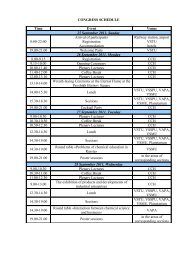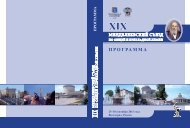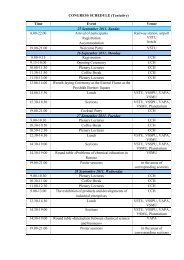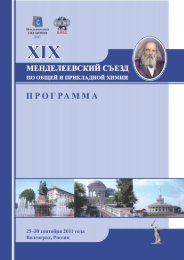scientific program (tentative)
scientific program (tentative)
scientific program (tentative)
Create successful ePaper yourself
Turn your PDF publications into a flip-book with our unique Google optimized e-Paper software.
Destroyed mill<br />
Address: Russia, Volgograd, Marshal Chuikov St., 47<br />
Address: Russia, Volgograd, Sovetskaya St., 39<br />
Address: Russia, Volgograd, Gogol St., 10<br />
www.stalingrad-battle.ru<br />
Address: Russia, Volgograd, Lenin Av., 7<br />
www.russianmuseums.info/M742<br />
Dilapidated red brick building of Stalingrad mill. The mill was<br />
built in 1904 by a German, Gerhardt. When restoring the city<br />
after the war, the mill was decided to be left as it was, as a living<br />
evidence of the devastating Battle of Stalingrad. The location<br />
of this monument identified a place for the museum «the Battle<br />
of Stalingrad», one of the exhibits of which is the building of the<br />
mill.<br />
Pavlov’s House<br />
Pavlov’s House is a 4-storeyed residential building in the<br />
center of Volgograd, where during the Battle of Stalingrad<br />
a group of Soviet soldiers under the command of Lieutenant<br />
J. F. Afanasyev and Sergeant Y. F. Pavlov held the defense.<br />
Volgograd Memorial and Historical museum<br />
Volgograd Memorial and Historical museum was opened<br />
in 1993 in a building which is a historical and architectural<br />
monument of national importance. In 1918 the headquarters<br />
of the Tsaritsyn Defense Council was placed there, in 1937 the<br />
Museum of Tsaritsyn Defense of J. V. Stalin was opened,<br />
in 1948 – the Museum of Tsaritsyn-Stalingrad Defense. The<br />
Museum covers the social, political, revolutionary and military<br />
events in Tsaritsyn.<br />
Volgograd Local History museum<br />
Volgograd Local History museum is located in the former<br />
building of the Noble Assembly of Tsaritsyn. The museum<br />
contains 40 thousand different documents and things. Exposition<br />
in the museum is built in a strictly chronological sequence. Here<br />
you can see festive clothing of Cossacks, peasant bast shoes,<br />
which were the main type of shoes of peasants until the middle<br />
of the XIX century.








